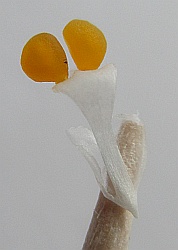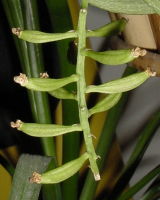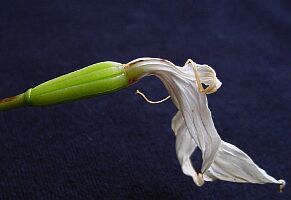How can I get some seeds?
Before you can start sowing seeds you have to solve the problem that seeds normally can not be bought in shops. So you have to pollinate your own plants. To pollinate an orchid the plant should be strong and healthy. To start building a capsule you have to transfer the pollinia of one flower to the stigma of an other plant. If you have got only one plant or only one flower you can transfer the pollinia to it's own stigma. Some orchids do not allow self pollination so we have to try if it accepts it's own pollinia or not.
Here are some examples of flowers where you can see where the stigma and the pollinia are.
In our three-dimensional simulation of a Paphiopedilum you can look at the flower from all sides and dissect it.
Our pollination technique
We use wooden toothpicks to transfer pollinia. The best time to pollinate your orchid is when the flower is about 3-4 days old. Move the end of the toothpick into the flower an pull out the pollinia. Sometimes the pollinia does not stick on the tootpick. In this case you should use a forceps to pull them out. In the next step remove the anther cap and place the pollinia on the stigma of the other flower, as close as possible to the entry of the stigma channel. Last but not least write down the pollination date and the name of the secound plant.

Basic rules to label the pollinated flowers
With some examples we want to show you the common way to label seed capsules and plants.
Name: Cattleya forbesii
Two Cattleya forbesii plants, grown from different parents, were crossed (pollinia from plant A was tranfered to the stigma of plant B).
Name: Cattleya forbesii x self
If the pollinia was taken from a flower of the same plant we call it a selfing. When crossing two plants which are grown from one meristem (in vitro tissue culture) or by cutting one plant into two parts it´s still a selfing.
Name: Cattleya forbesii x sib
When crossing two plants which are grown from the same parents we call it a sibling (plants are grown from one seed capsule and this plants are crossed).
Name: Cattleya forbesii x rex
A Cattleya forbesii was crossed with a Cattleya rex.
Name: Cattleya forbesii x Laelia crispa
A Cattleya forbesii was crossed with a Laelia crispa.
From pollen transfer to a mature capsule
When you put the pollinia on the stigma of a flower, the pollen produce tubes, which grow through the stigma channel to the femal ovule in the ovary. As soon as the tubes arrive in the ovary ovule get pollinated and seeds start to develope. Sometimes the pollination fails and the plants drops the capsule. The following table lists how long it takes from pollinia transfer till the ovule gets pollinated.
| Oncidium ampliatum | 45 - 50 days |
| Cattleya bowringiana | 60 - 65 days |
| Dendrobium nobile | 75 - 80 days |
| Encyclia cordigera | 120 - 150 days |
Harvesting capsules
The seeds inside the capsule have finished their development about 3/4 of the time the capsule needs from pollinia transfer till releasing the mature seeds. If you want to sow green capsules (in vitro) you can harvest them after this time. It´s very important that the green capsule has no holes or places where fungi could reach the seeds otherwise they are not free of contaminations (fungi, bacteria, ...).

(3 months old)

(3 months old)

(3 weeks old)
For sowing dry seeds just wait till the capsule starts to open (dehisces) and then harvest it.
| Acampe | 16 1/2 months |
| Angreacum | 5 1/2 months |
| Bifrenaria | 8 months |
| Bulbophyllum | 3 months |
| Calanthe | 4 months |
| Calyptrochilum | 8 months |
| Cattleya | 11 months |
| Coelogyne | 13 months |
| Cymbidium | 10 months |
| Cyrtorchis | 7 months |
| Dendrobium | 12 months |
| Dendrobium nobile | 6 1/2 months |
| Dendrobium phalaenopsis hybrids | 5 months |
| Dendrobium pierardii | 14 months |
| Disa uniflora | 6 - 7 weeks |
| Doritis | 7 1/2 months |
| Epidendrum | 3 1/2 months |
| Googyera | 1 month |
| Laelia | 9 months |
| Laelia brysiana | 5 months |
| Laelia furfuracea | 3 months |
| Maniella | 1 month |
| Masdevallia | 4 months |
| Maxillaria | 10 months |
| Miltonia | 9 months |
| Odontoglossum | 7 months |
| Odontoglossum cordatum | 5 - 6 months |
| Paphiopedilum | 10 months |
| Paphiopedilum lowii | 4 months |
| Paphiopedilum parishii | 5 months |
| Phalaenopsis | 6 months |
| Phalaenopsis farbige | 8 months |
| Phalaenopsis lueddemanniana var. hieroglyphica | 12 1/2 months |
| Stanhopea | 7 months |
| Vanda | 20 months |
| Listera ovata | 1 month |
| Ophrys sphecodes | 2 months |
| Cypripedium | 3 months |
Author: Thomas Ederer
